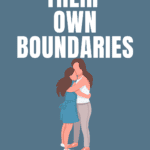Learn the benefits of teaching kids to set boundaries on their own, and why it is crucial for parents to teach their kids to say no.
When we talk about kids and boundaries, the conversation is almost always around PARENTS setting boundaries FOR kids.
Rarely do we talk about teaching children how to set their own boundaries. We tell kids to stay out of trouble, urge them to be safe, and hope that they will stand up for themselves. But we usually don’t explain to them how to do these things.
We DO teach kids that they have to listen to adults and practically follow rules blindly, but what if that very thing could actually lead them into harms way.
I always thought that was an acceptable parenting method, until recently when a trusted member of our community was found to be doing inappropriate things with children.
Suddenly, all my opinions about trusting adults to set boundaries for kids crashed and burned.
Teaching kids to say no is not only about protecting them from harmful situations but also about instilling in them the values of self-respect and self-worth. Whether you’re a parent, teacher, or caregiver, these insights will help you understand the benefits of boundaries, teach children how to say no, and help your child identify when boundaries are crossed.
Related: 6 Ways Parents Can Teach Kids to Think Critically

The Benefits of Setting Healthy Boundaries
There are many benefits to setting healthy boundaries, both for children and adults. When we set boundaries, we create a sense of safety and predictability in our lives.
For kids, setting boundaries can help them develop a strong sense of self and build healthy relationships. When kids know how to say no and set limits, they are less likely to be taken advantage of or bullied by others.
They are also more likely to form positive relationships with peers who respect their boundaries and value their opinions.
In addition to these benefits, setting healthy boundaries can also improve mental health and reduce stress. When we feel in control of our lives, we are less likely to experience anxiety or depression. We can also manage stress more effectively by setting realistic expectations for ourselves and others.
Also Read: 5 Safety Topics Kids Don’t Know unless Parents Teach Them
5 Ways to Teach Kids How to Say “No”
Teaching kids to say no can be a delicate balancing act. On the one hand, we want our kids to be assertive and confident, but on the other hand, we don’t want them to come across as rude or disrespectful.
Here are 5 tips for teaching kids to say no in a constructive and respectful way:
1) Use “I” statements
Encourage kids to express their feelings using “I” statements like “I feel uncomfortable” or “I don’t want to.” This approach is less confrontational and more assertive than saying “you’re wrong” or “I hate that.”
Also Learn 7 behaviors children only learn from watching parents.
2) Practice saying no
Role-play different scenarios with your child, such as saying no to a friend who wants to borrow their toy or saying no to a stranger who offers them candy.
This practice can help kids feel more confident and prepared when faced with similar situations in real life.
Follow these 5 tips to Raise Free Thinkers.

3) Offer alternatives
When saying no, it’s important to offer alternatives whenever possible.
For example, if a friend wants to play a game that your child doesn’t like, they can suggest a different game they both enjoy instead.
Follow these tips if you think you are too strict or a helicopter parent.
4) Use positive language
Encourage kids to use positive language when saying no, such as “I appreciate your invitation, but I have other plans.”
This approach is more respectful and less confrontational than saying “I don’t want to” or “that’s stupid.”
5) Reinforce positive behavior
When your child successfully says no or sets a healthy boundary, praise them for their assertiveness and courage.
This positive reinforcement can help them build confidence and develop their skills further.
Also read: 7 Signs You are Raising a Resilient Child

Teaching Kids to Recognize when a Boundary is being Crossed
Another essential aspect of teaching kids to say no is helping them recognize when a boundary is being crossed – and when to be alarmed.
Children may not always know when they are being mistreated or taken advantage of by others.
As parents and caregivers, it’s crucial to help them identify the signs of a boundary violation and encourage them to speak up when they feel uncomfortable or unsafe.
Some common signs of a boundary violation in children might include:
- Feeling scared or anxious around a particular person
- Being pressured into doing something they don’t want to do
- Feeling physically or emotionally uncomfortable in a situation
- Being made to feel guilty or ashamed for saying no
By teaching kids to recognize these signs, we can help them protect themselves from harm and build the confidence they need to set healthy boundaries in the future.
Learn how to Raise an Emotionally Secure Child here.
Final Thoughts on Teaching Kids to Set Boundaries
Teaching kids to say no (and identify when to say no) is one of the most important safety and self-preserving lessons we can teach our children.
By helping our children understand what boundaries are, why they matter, and how to set them, we can prepare them to navigate the challenges of life with resilience and self-assurance.
With the right tools and resources, we can empower our kids to say no and set healthy boundaries, setting them up for a lifetime of success and happiness – and most importantly safety.
For more tips on raising kids who are healthy at home and strong in the world, follow us on Facebook.

